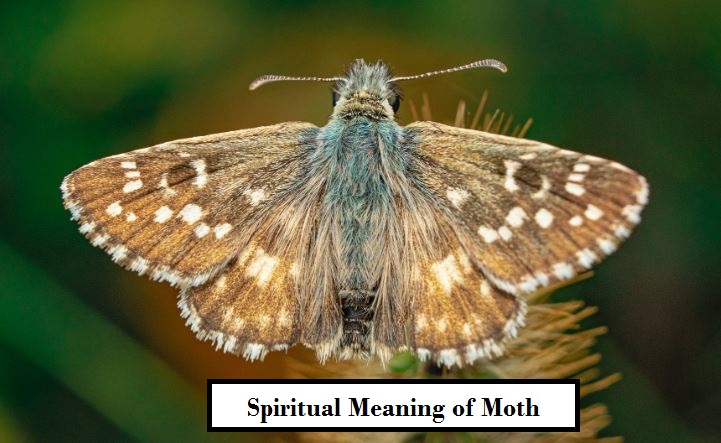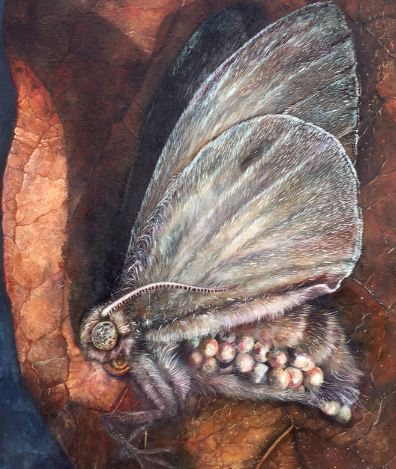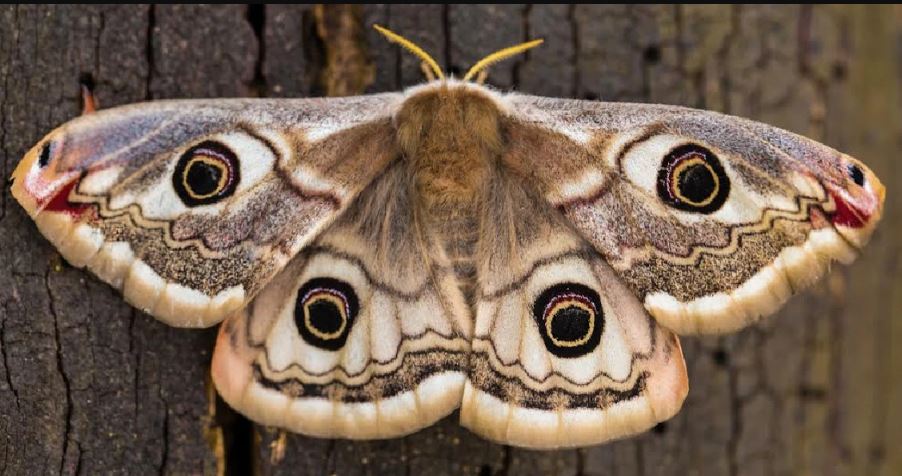Moths are fascinating creatures that have captured the human imagination for centuries. They are nocturnal creatures that are attracted to light, which has led to various spiritual and cultural interpretations of their symbolism.
In this article, I will explore the Spiritual Meaning of Moth and their significance in different spiritual traditions and cultures across the globe.

Understanding Moth Symbolism
The symbolism of moths has traversed various cultures and belief systems throughout history. These creatures have consistently been linked with themes of transformation, vulnerability, and an affinity for light.
Their preference for the night and their allure of moonlight contribute further to their enigmatic attributes.
Transformation and Metamorphosis
Central to the symbolism of moths is the concept of transformation. Similar to butterflies, moths undergo metamorphosis, progressing from caterpillars to fully developed winged insects.
This metamorphic journey serves as a potent representation of personal development, adaptation, and renewal.
Moths serve as a reminder that change is an intrinsic facet of existence, urging us to embrace it to foster growth and advancement.
Vulnerability and Fragility
Despite their robust nature, moths are often perceived as delicate and susceptible due to their gentle wings and tender bodies.
This fragility serves as a mirror to our own vulnerabilities as humans. Much like moths, we may find ourselves exposed and defenseless at times.
Yet, this fragility doesn’t equate to weakness. It stands as a testament to our shared humanity, underscoring our need for mutual support and empathy.
Attraction to Light
Moths are renowned for their attraction to light sources. Yet, this allure frequently steers them off course, causing them to flutter around artificial lights instead of following their innate instincts.
This behavior symbolizes the allure of temptation and diversion, acting as a reminder for us to remain resolute in our objectives and to sidestep distractions that could impede our progress.
Nocturnal Nature and Moonlight
Moths, creatures of the night, come alive during nocturnal hours. This association with darkness embodies elements of mystery, intuition, and the uncharted. Moreover, moths share a profound link with moonlight and its transformative energies.
The moon’s influence on natural rhythms is well-documented, believed to extend to our emotions and spiritual well-being.
Spiritual Meaning of a Moth
Moths, creatures of the night, possess a fascinating attribute, particularly their intriguing attraction to light.
As outlined in this referenced article, the phenomenon remains enigmatic. The prevailing hypothesis suggests that female moths emanate a vibration of a specific frequency, akin to light, leading moths to misinterpret artificial illumination as a manifestation of feminine energy.
Their innate attraction to this feminine light becomes overpowering in the face of such potent artificial illumination.
This potentially mirrors our spiritual journey. Our individual compass guides us towards deeper significance in life. For some, this pursuit materializes as a quest for a spiritual purpose.
Others, while seeking meaning and solace in the tangible realm, gravitate towards intense, distracting luminance like that of sex, wealth, substances, and more.
Rooted in our earthly existence, the quest for purpose and a rightful place within it remains perpetual. Amidst this quest, we can become ensnared by earthly pleasures and comforts, which often convey distorted impressions of profound truths.
What Does a Moth Symbolize?
Moths signify many things, depending on the culture and context. Below are some of the most common moth symbolism:
Intuition and Inner Guidance
Moth symbolism embodies the concepts of intuition and internal guidance, stemming from the deep rapport these nocturnal creatures share with their instincts. Moths are renowned for their capacity to maneuver through darkness, relying on an intrinsic sense of direction.
This adeptness enables them to gravitate toward sources of light. This innate ability to heed their instincts stands as a potent emblem of the significance of self-trust when confronting challenges.
Vulnerability and Fragility
Moths are commonly perceived as gentle and delicate beings, characterized by their fragile wings and tender bodies.
Their symbolism frequently intertwines with notions of vulnerability and delicacy, offering a poignant reminder of the value of safeguarding and nurturing the aspects of our lives that are easily susceptible to harm.
For centuries, people have been captivated by the elegance and allure of moths. Drawn to light, they engage in graceful nocturnal dances around luminous sources. Yet, despite their tranquil demeanor, moths remain susceptible to harm and fragility, their exquisite appearance making them susceptible to damage.
Death and Rebirth
Within specific cultural contexts, moths hold dual symbolism, representing both the concepts of death and rebirth. This connection to mortality originates from the moth’s life cycle an evolution from caterpillar to cocoon, culminating in the emergence of a mature moth.
This sequence parallels the cycle of existence and demise, wherein an organism progresses through phases of development, followed by a phase of alteration or “death,” only to be reborn anew in a transformed manifestation.
Transformation
Moths are captivating beings that embark on a remarkable journey of transformation called metamorphosis, encompassing a series of well-defined phases. This process commences with the moth’s existence as a caterpillar, a stage known as its larval phase.
Throughout this period, the caterpillar dedicates its time to feeding and expanding in readiness for the subsequent chapter of its development.
Faith and Spirituality
In specific cultural contexts, moths are held to carry profound spiritual implications, embodying a symbol of divine intervention or direction.
This conviction originates from the observation that moths are naturally drawn to light, a phenomenon intertwined with spiritual enlightenment and wisdom.
Moths, creatures of the night, possess an affinity for man-made sources of light like lamps and streetlights.
Attraction to Light
Moths, creatures of the night, are renowned for their magnetic pull toward light.
They possess an inherent inclination to soar towards any glimmering beacon they encounter, a behavior that frequently guides them in orbit around lamps, candles, and various luminous focal points.
Nevertheless, this conduct also holds the potential for symbolic interpretation.
Death and Rebirth
Within the realm of spiritualism and across diverse cultures, moths have been intertwined with the profound notions of mortality and rejuvenation.
The symbolic resonance of moths within this framework originates from their life cycle, marked by a progression from an egg to a caterpillar, then to a pupa, culminating in their emergence as adult moths.
This metamorphic journey mirrors a sequence of development, alteration, and resurgence.
Love and Attraction
Across the annals of history, moths have held affiliations with love and allure across diverse cultural landscapes.
Within China, moths stand as emblems of loyalty and matrimonial harmony. In the tapestry of Japanese culture, they are intertwined with the essence of genuine love and the quest for kindred spirits.
Guidance and Protection
Moths are perceived as bearers of guidance and safeguarding. Within certain cultural contexts, the sight of a moth is held to signify not only auspicious fortune but also a shield against adversity.
Their inclination toward the night, coupled with their link to moonlight, serves as a representation of intuition and internal counsel, prompting us to have faith in our instincts and heed our inner resonance.
What is the Difference Between a Moth and a Butterfly?
distinctions between moths and their close counterparts, butterflies.
Moths and butterflies share membership in the same insect Order known as Lepidoptera. The world harbors a remarkably extensive array of moth species, totaling around 160,000, far surpassing the 17,500 species of butterflies.
However, scientists propose the potential for an even larger tally potentially half a million species given that not all have been formally identified.
An unmistakable contrast between moths and butterflies lies in their antennae. Moths typically bear antennae adorned with feathery filaments, devoid of a terminal ball, whereas butterflies possess slender antennae concluding with a small spherical tip.
Moreover, moths often exhibit heftier, more densely furred bodies in comparison to their butterfly counterparts.
Check Here: Orchid Spiritual Meaning
Dead Moth Meaning

Numerous individuals tend to associate encountering deceased animals or insects with negative omens. Naturally, the notion of death can evoke discomfort. Yet, the concept of death itself need not be viewed with trepidation.
Biologically speaking, encountering a deceased moth can be an entirely natural occurrence, given the relatively brief lifespan of moths.
However, from an environmental perspective, an excessive decline in moth populations beyond the natural order could signal concern, prompting us to delve deeper, gain insight, and initiate appropriate measures.
Moth Color Meanings and Symbolism
The interpretations of moth colors exhibit slight variations across different cultures. Nevertheless, the following are some widely shared connotations:
White Moth Meaning
White embodies concepts of purity, innocence, simplicity, clarity, and celestial beings like angels. Additionally, the color white holds connections to your crown chakra, facilitating a link between your existence and the ethereal realm.
In this light, the sighting of a white moth could signify a message from a spirit guide or a departed loved one, extending their warm greetings to you.
Brown Moth Meaning
Brown moth spiritual meaningelements such as wood, soil, Earth, security, and stability. The essence of the color brown is encapsulated in the expression “very down to Earth,” connoting authenticity, relatability, and absence of affectation.
When encountering a brown moth, it can serve as a gentle nudge to reconnect with your roots and fundamental principles. Fostering and cherishing the supportive and authentic facets of your life paves the way for optimal flourishing.
Black Moth Meaning
Among black moths are the black witch moth, the American bird’s wing moth, the black geometrid moth, and several others.
The color black embodies notions of elegance, formality, mystery, beauty, rebellion, and transformation. The absence of black would leave other colors devoid of the richness in depth and tone they possess.
Observing a black moth can indicate an impending shift in your life’s trajectory.
Moths in the Bible, Judaism, and Christianity
The concept of moths consuming clothing, or fabric, has its origins in biblical times. Yet, the reality is that only a few moth species out of the extensive array actually partake in this behavior. Still, moths faced negative connotations within biblical contexts.
For instance, in the Book of Job, chapter 13, verse 28, Job’s words capture a sense of skepticism regarding human capabilities, especially those who lack faith in a higher power. He likens human deterioration to that of a decaying object, much like a moth-eaten garment.
In essence, Job’s commentary reflects cynicism about the prowess of human beings, particularly those who lack faith in a divine presence.
Furthermore, in Matthew 6:19-20, a caution is issued against investing unwavering faith in material possessions devoid of spiritual significance:
“Do not amass treasures for yourselves on earth, where moths and rust destroy, and where thieves break in and steal. Instead, accumulate treasures for yourselves in heaven, where neither moth nor rust destroys, and where thieves do not break in or steal.”
These references underscore Job’s skepticism toward human strength in the absence of faith and emphasize Matthew’s counsel to prioritize spiritual treasures over transitory earthly possessions that are susceptible to decay and theft.
Moth Meaning in Buddhism
As previously mentioned, within Buddhism, the moth frequently stands as a symbol mirroring attachment desiring possessions, results, or circumstances that are ultimately unbeneficial, leading to discontentment or suffering when these desires remain unfulfilled.
In a particular narrative, Buddha found himself seated in the gardens of Jetavana Monastery on the outskirts of Savatthi, India, one evening.
Engaged in meditation, he observed moths swirling about and inadvertently plunging into oil lamps. This observation prompted Buddha to recognize that those moths who were driven to seek the light, albeit excessively fervent in their pursuit, ended up consumed by the flames.
Moth Meaning in Hinduism
Within Hinduism, moth-related metaphors serve as a means to portray vulnerability or the act of straying from profound spiritual values.
In the Bhagavad Gita, Chapter 11, Verse 28-29, it is expressed: “Just as numerous currents of rivers surge towards the ocean, similarly, all these mighty warriors rush into Your fiery mouths.
Moth in house meaning Hindu into fire’s embrace for their demise, likewise, these armies hurry into Your mouths with unswerving haste.”
Moth Symbolism in Sufism
Sufism interprets the moth-to-flame metaphor with a nuanced perspective. Within Sufi beliefs, an individual who yearns for enlightenment or a profound connection to the divine is occasionally likened to a moth drawn to a flame.
Here, the concept of self-annihilation, known as “fana” in Sufism, signifies the seeker relinquishing their sense of self to merge with the divine essence.
Renowned Sufi poet and philosopher Rumi articulated this sentiment:
“Abandon pretense as a candle, embrace the role of a moth. Thus, you may savor the essence of Life, and unearth the potency concealed within love.”
Moth Spirit Animal

When the Spirit of the Moth graces your presence, it’s a cue to lower your head and embrace silence. The Moth recognizes that you’ve become overly exposed, inadvertently displaying your vulnerabilities to individuals who may not be deserving of your complete trust.
The Moth Spirit Animal offers guidance in discerning those worthy of your favor and those for whom you should adopt a more guarded facade.
You see, the Moth Spirit comprehends the intricacies of vulnerability and the reality that diversions can easily ensnare you. Bright lights beckon us, but the time has come to recalibrate your direction toward a more secure sanctuary.
Moth Totem Animal
Individuals aligned with a Moth Totem Animal remain optimistic even in the midst of darkness. They’re the beacons of cheerfulness you seek when the night appears unending. These people possess a penchant for detail, displaying an attentiveness to minutiae that often escape others’ notice.
If the Moth serves as your Birth Totem, your discernment extends from your choice of attire to your social spheres. You understand your innate capacity to draw attention with ease.
Consequently, you eschew unnecessary fuss. You believe that the circumstances and individuals you desire in your life will naturally gravitate toward you. The Law of Attraction seems to be ingrained within your very being.
Check Here: Red Bird Spiritual Meaning
Moth Power Animal
Turn your gaze towards the Moth Power Animal, fluttering with excitement within you, especially when the time calls for candor. The essence of the Moth revolves around authenticity, especially in matters of emotions. It encourages you to express your genuine feelings, rather than merely catering to the expectations of others.
Moreover, the Moth Power Animal assumes the role of a catalyst. When motivation or inspiration is sought, the Moth takes flight with a substantial infusion of optimism, guiding your journey.
Native American Moth Symbolic Meanings
In the coastal regions of California, the Moth embodies concepts of healing, metamorphosis, and a life imbued with prayer. Cocoon remnants discovered are transformed into essential components of sacred rattles employed in distinct rituals.
For certain tribes, the Moth serves as a guide when engaging with matters associated with death, encompassing divination and interactions with spectral emissaries.
Moth in Dreams
Much like the natural occurrence of a Moth, its presence in dreams can signal a transformation a transition rather than a physical cessation. It signifies the culmination of one life chapter and the commencement of another.
When Moth flits before your dream eyes, it hints at a significant aspect you might have overlooked. Pay careful attention to its subsequent flight path or where it comes to rest, as these cues can provide profound understanding.
Should the dream Moth come to rest upon your stomach, it points to a concealed secret dwelling within your depths. A decision lingers on whether unveiling this hidden truth is the most fitting course of action.
Is a Moth a Bad Omen?
Given the constant association of moths with themes of death, night, and adversity, you might question whether the sight of a moth signifies an unfavorable omen.
While the two types of moths mentioned earlier have gained notoriety in popular culture as bearing ill intentions, it’s essential not to misconstrue this portrayal as a universal truth for all moths. It’s crucial to recognize that moths encompass an array of thousands of species.
From a spiritual standpoint, moths are not harbingers of misfortune. Their presence typically conveys warnings regarding distractions in your life or offers encouragement to persist on your spiritual journey.
Moths can symbolize the shadowy facets of change, including loss and conclusions, yet they also signify the advent of fresh opportunities to fill the void left behind.
Moth Is Flying Around You Meaning
Given that moths are creatures of flight, instances where they fly towards us or flutter around us are more commonplace than one might assume. This phenomenon, where moths encircle your head, has caught the attention of many. So, what does it signify?
When a moth orbits your head in flight, it serves as an indication of your profound link to intuition, with your psychic faculties awakening. This occurrence frequently aligns with clairvoyance, mediumship, and messages emanating from the spiritual plane.
Situated in the vicinity of the head, the crown and third eye chakras house the most elevated frequencies within your energy centers. This underpins their affiliation with spiritual energies.
Moth in Your Home Meaning
Spiritual meaning of moth in house might evoke feelings of unease or aversion, or their recurring appearance could pique your curiosity about potential underlying significance. Does it warrant fear, or does it carry a positive connotation?
There exist two distinct categories of moths that can find their way into homes, each raising particular queries: nocturnal moths that venture indoors from the external environment, and wardrobe moths that target your sustenance and attire.
The entry of nocturnal moths into your abode should be seen as an encouraging indication. It signifies the initiation of profound healing processes in the root chakra or the foundational energy center associated with your home.
The healing here introduces stability to diverse aspects of your life, encompassing financial matters, relationships, and health, and reinforces a sense of belonging.
Also, Check here: Spiritual Meaning of Chipmunk
What Does it Mean To Find a Dead Moth?
Encountering a deceased moth embodies the energy you’re clinging onto from your history that’s ripe for release. This might encompass a former relationship, a fractured friendship, or any recurring memory that you continually revisit.
Moths embody the concept of transformation, symbolized by their connection to death. However, this isn’t the irrevocable demise we witness in the material world. In a spiritual context, death invariably fosters development and fresh commencements.
When you witness a lifeless moth, incapable of growth or transformation, it signifies an impediment obstructing a facet within you from evolving or undergoing change.
Conclusion
In contrast to the nearly universal admiration for butterflies, moths tend to evoke considerable discomfort and anxiety.
Nevertheless, among those who possess an affinity for these creatures of the night, the moth’s fragile beauty has elevated it to a significant favorite. Moths serve as poignant reminders of the remarkable rhythms inherent in life’s cycles.
Visit thespiritualmeans.com for more stuff!
People Can Also Search For:
- brown moth in the house meaning
- Spiritual meaning of moth flying
- moth spiritual meaning love
- grey moth spiritual meaning
FAQs
Moths carry diverse spiritual meanings across cultures. They often symbolize transformation, vulnerability, intuition, and attraction to light.
Yes, in many cultures, moths are regarded as spiritual messengers. Their nocturnal nature and attraction to light make them symbolic of guidance, intuition, and divine intervention.
Moths in dreams can signify transformation, change, or a shift in your life. A moth flying around you could indicate a strong connection to your intuition and heightened psychic senses.
Yes, moths are often associated with the concept of death and rebirth. Their life cycle mirrors this cycle of transformation, where an organism undergoes change and renewal.
When a moth lands on you, it can symbolize a message from the spiritual realm. It’s often seen as a reminder to pay attention to your intuition, as well as an indication that you’re on the right path spiritually.
The attraction of moths to light is a behavior known as phototaxis. While the exact reason is not fully understood, which they use for navigation.
Different colors of moths can carry distinct spiritual meanings. For instance, white moths often symbolize purity and spiritual growth, transformation, or rebirth.
Yes, moths often associated with the crown and third eye chakras. These chakras are connected to higher spiritual energies and intuition. Moth symbolism can represent the alignment of these chakras.
Absolutely. While moths might see as symbols of vulnerability or change, they also emphasize embracing the journey of transformation.
You can integrate moth symbolism into your spiritual practice by meditating on their traits, keeping artwork or figurines as reminders, or even creating rituals that involve moth imagery.

Mastin Kipp is a modern spiritual teacher, author, and entrepreneur known for his work in the field of personal development and self-help. Kipp’s teachings often focus on topics such as self-love, healing from past traumas, and creating a life of purpose and fulfilment.
